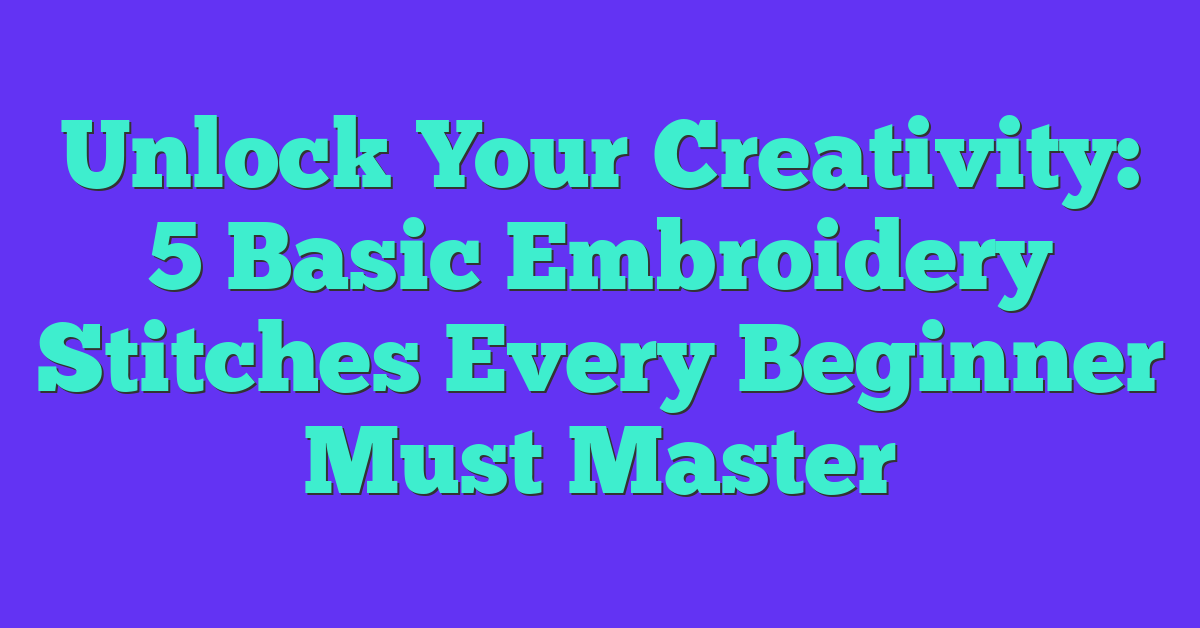Embroidery is a wonderful way to express your creativity and add unique touches to your projects. When you’re just starting out, learning the right stitches can make all the difference. I remember feeling overwhelmed at first, but once I mastered a few basics, everything became so much more enjoyable.
In this article, I’ll share five essential embroidery stitches that every beginner should know. These simple techniques will help you build confidence and create beautiful designs with ease. Whether you’re working on a personal project or looking to try a new hobby, these stitches are the perfect place to begin.
Let’s dive in and start your embroidery journey together. You’ll be amazed at how quickly you can create something truly special with just a needle and thread.
Running Stitch
The running stitch lays the groundwork for many embroidery projects. It’s easy to master and highly adaptable for various designs.
How to Perform the Running Stitch
I start by threading my needle with embroidery floss and tying a secure knot at the end. Bringing the needle up through the fabric, I insert it back down approximately 1/8 to 1/4 inch away. Maintaining even spacing and steady tension, I continue this process to create a consistent line.
Best Uses for Running Stitch
- Outlining: Define the edges of your designs.
- Decorative Borders: Enhance the borders of your projects.
- Basic Lettering: Craft simple, clear text.
- Sewing Seams: Attach fabric pieces securely.
- Adding Texture: Introduce subtle details to your embroidery.
Backstitch
Backstitch offers a strong, continuous line, perfect for defining your embroidery designs with precision.
How to Perform the Backstitch
Start by bringing your needle up through the fabric where you want your line to begin. Take a small stitch backward, inserting the needle back where the first stitch started. Move forward to a new point, then stitch back again to the previous point. Repeat this process, creating a solid line. Keep your stitches evenly spaced to maintain consistency and control throughout your design.
Best Uses for Backstitch
Backstitch excels in outlining intricate patterns, enhancing borders, forming detailed lettering, sewing seams securely, and adding defined lines to various embroidery projects.
Satin Stitch
I use the satin stitch to create smooth, filled areas in my embroidery projects.
How to Perform the Satin Stitch
- Start the Thread: I thread my needle and knot the end.
- Begin Stitches: I bring the needle up through the fabric at the starting point.
- Make Parallel Stitches: I insert the needle back down parallel to the first stitch, keeping even spacing.
- Continue Filling: I repeat the parallel stitches closely to fill the shape evenly.
- Secure the Thread: I finish with a small knot to prevent unraveling.
Best Uses for Satin Stitch
- Filling Shapes: I achieve smooth, solid areas in floral designs.
- Lettering: I create bold, defined letters for personalized embroidery.
- Borders: I enhance edges with a clean, filled look.
- Decorative Accents: I add texture and detail to various embroidery projects.
- Appliqué: I securely attach fabric pieces with filled seams.
French Knot
A versatile stitch, the French knot adds texture and dimension to embroidery projects. I find it perfect for creating tiny details and embellishments.
How to Perform the French Knot
- Threading: Thread your needle, ensuring the thread is secure by tying a knot at the end.
- Positioning: Bring the needle up through the fabric where you want the knot.
- Wrapping: Hold the thread with your fingers and wrap it around the needle two to three times.
- Inserting: Insert the needle back into the fabric close to the original entry point.
- Tightening: Gently pull the needle to tighten the wraps into a knot on the fabric surface.
Best Uses for French Knot
- Accentuation: Adding sparkle to floral designs.
- Detailing: Enhancing patterns with small, raised dots.
- Embellishments: Creating decorative elements on clothing and accessories.
- Texture: Introducing dimension to plain areas in embroidery.
- Highlighting: Emphasizing specific parts of a design for visual interest.
Chain Stitch
Chain stitch creates a series of looped stitches that form a continuous line. It’s perfect for adding decorative borders and intricate patterns to your embroidery projects.
How to Perform the Chain Stitch
- Thread the Needle: Use a double strand of embroidery floss for durability.
- Start the Stitch: Bring the needle up through the fabric at your starting point.
- Create the First Loop: Insert the needle back into the fabric a short distance away, leaving a loop.
- Form the Chain: Bring the needle up through the loop to form a chain.
- Repeat: Continue the process, maintaining even spacing for a consistent appearance.
- Finish the Stitch: Secure the end with a small knot behind the fabric.
Best Uses for Chain Stitch
- Decorative Borders: Enhance the edges of your designs with a flowing chain.
- Intricate Patterns: Create detailed motifs and floral designs with ease.
- Highlighting Details: Add emphasis to specific areas in your embroidery.
- Textured Lines: Introduce dimension and texture to your projects.
- Lettering: Form elegant and continuous lines for names and messages.
Conclusion
Embarking on my embroidery journey has been incredibly rewarding and I hope you’re feeling the same way. These five basic stitches are just the start of what you can create with a little patience and creativity.
Keep practicing and don’t hesitate to experiment with different designs. Before you know it you’ll be crafting beautiful pieces that reflect your unique style. Happy stitching!


















